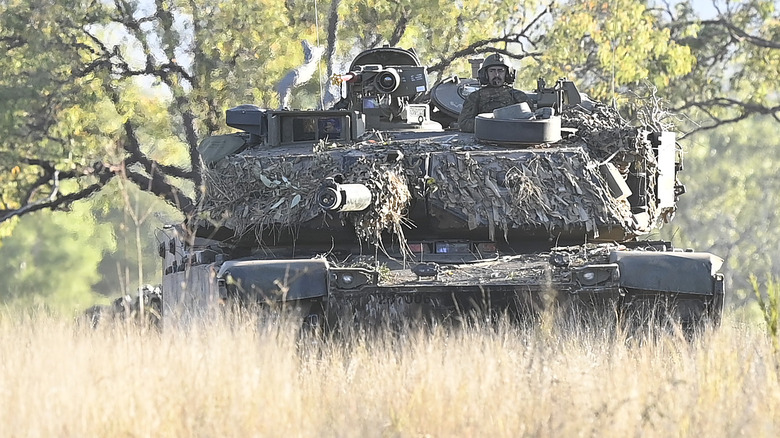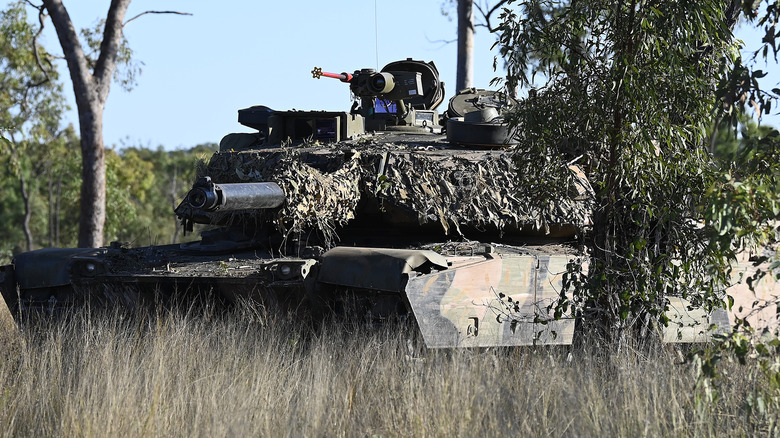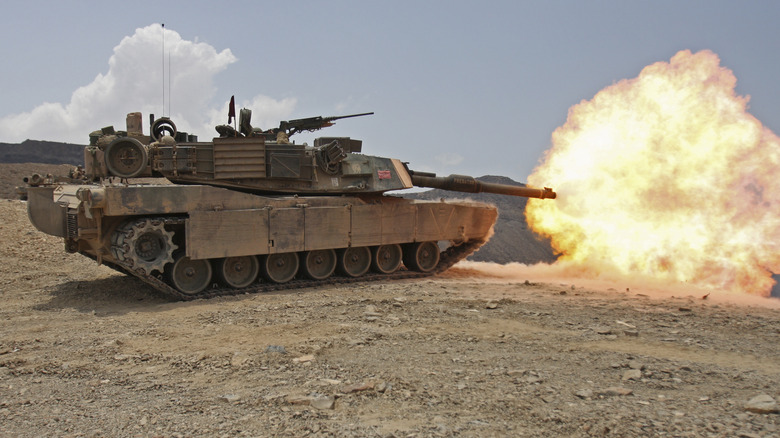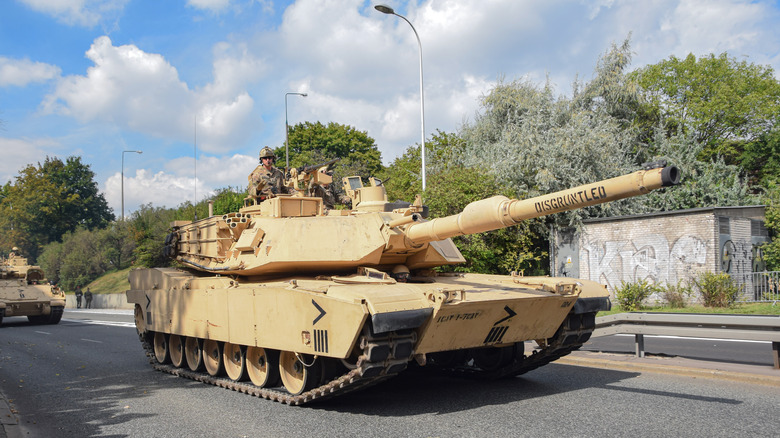The Biggest Weaknesses Of M1 Abrams Tank
There's really no denying the high regard in which the M1 Abrams tank family is held. The original model first arrived with the United States military in 1980, a model that would be equipped with the British Chobham armor, a composite material concept that provides more protection than the simple, increasingly thick metal plates that tanks had traditionally employed prior. With its 105mm L7 main armament, the very first M1 Abrams was a force to be reckoned with.
The Abrams family would represent a huge stride forward for the nation in the arena of the main battle tank, a breed that rose to prominence in the post-World War II landscape. Intended to be resilient but not too heavy, maneuverable but not too light and vulnerable, the Abrams set out to define itself as a versatile and powerful weapon. An effective one it may have proven to be, but it certainly wasn't and isn't a perfect one.
Prominent in global conflict from the Gulf War to the war in Ukraine, the extensive use of the M1 Abrams family has also brought some of its shortcomings to the fore. Let's take a look at the range, weight, anti-tank vulnerabilities, and other prominent weaknesses of this acclaimed tank family.
Its ever-increasing weight
The first Abrams model weighed approximately 55 tons. A good deal of this weight, according to the First Division Museum, can be attributed to the addition of advanced Chobham armor. This form of protection, particularly in its early guise, was too bulky to be practical on smaller vehicles, and it would take its toll on the Abrams.
The proliferation of the Abrams (by 2017, over 10,280 of them had been manufactured) has resulted from the model being continually iterated upon rather than replaced or rendered obsolete. Its armor has been steadily upgraded over the decades. Advanced protection using depleted uranium has allowed the Abrams to withstand a wide range of threats, but the density of sheets of such a material, when applied to more vulnerable areas of the tank (and in tandem with specially reinforced compartments to protect from and contain ammunition explosions), made it very heavy. Indeed, Guinness World Records awarded the M1A2 Abrams, which first arrived in 1990, the record of "heaviest tank (present-day)." At just under 139,000 lbs or 63 metric tons, it's certainly a formidable machine.
The issue is that this weight continues to increase. In January 2021, Defense News stated that the Pentagon's Director of Operational Test and Evaluation concluded in a report that "weight growth limits the tank's tactical transportability. The M1A2 SEPv3 is not transportable by current recovery vehicles, tactical bridges or heavy equipment transporters." At the time, the M1A2 Abrams had hit 73.6 tons.
Logistics and maintenance difficulties
The M1 Abrams was designed to be versatile, both in defense and on the attack. Its sheer size, however, came to limit this. The wide range of added functionality and improvements that would be added also contributed to this issue. The SEPv3 version from 2020, which added features like Next Evolution Armor and the option of a more efficient power supply, also added further heft. The Pentagon's January 2021 report concluded that SEPv3 "introduce[s] suitability concerns," partially for this reason (via Defense News).
The Abrams is a sophisticated tank, with the latest SEPv3 model boasting a Honeywell AGT1500 with 1,500 horsepower, capable of around 42 mph. This model added Joint Battle Command functionality to the M1A2's existing Position/Navigation system and Inter-Vehicle Information System functionality, all of which allow it to automate tasks and locate other vehicles and targets more easily. As with any piece of technology, though, a wide suite of advanced features can mean maintenance and repairs become rather trickier.
This issue is exacerbated when the Abrams is operated overseas by other nations' militaries. In September 2023, the United States' M1 Abrams began to arrive in Ukraine, the weapon being quite a boon to Kyiv's forces. At the same time, their unfamiliarity and complex technology could make working with them rather difficult. As The Wall Street Journal put it, "Depending on what needs to be repaired, the parts may need to be sent all the way back to manufacturing plants in the US."
Its temperamental engine
As we've seen, the Abrams is a very heavy tank. Typically, this shortcoming would result in limited speed and practicality (as with a certain gigantic Panzer tank). While this does negatively impact it in certain areas, it doesn't make it slow. Maxing out at around 45 mph, in fact, it's surprisingly sprightly. The Abrams family owes this to its AGT1500 engine. Honeywell Director of Large Turboshaft Engines, Justin Paulus, explains: "It's essentially a jet engine powering a military land vehicle for the first time. Diesel engines had always been the standard."
This jet engine offers quieter operation and impressive speed for the size of the vehicle, but one disadvantage of a jet engine tank is that it can be fuel-hungry. Keeping everyone topped up is an essential element of the logistics of almost any vehicle fleet, and it could be an even greater priority with the Abrams as a result. 0.6 miles per gallon (in the case of the M-1A1SAs) is far from impressive.
Terrain is another vital concern. The engine is equipped with air filters, which require rigorous and regular emptying to keep the vulnerable engine clear of unwelcome particles. Engine damage can result in lengthy repairs and long trips to a place capable of performing them. Ultimately, the M1 Abrams' strengths come hand in hand with vulnerabilities. Its Trophy system, for instance, adds considerably to its weight: around 5,000 lbs. The key to its long-term application has been balancing both.



